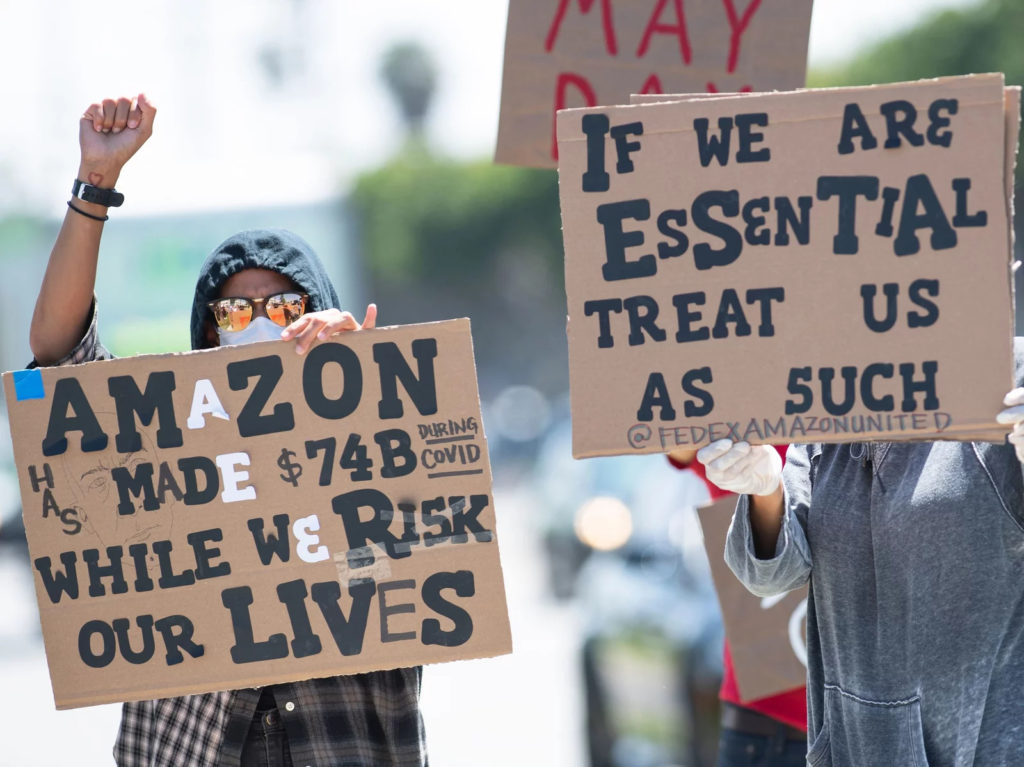
Amazon wokers demonstrating for their rights
During the past year, as the pandemic reshaped our daily lives, the media has paid more attention to work and workers than it has in a long time. The pandemic has shone a spotlight on the deep inequalities that persist in the US labor force—where women and workers of color are over-represented in low-wage, frontline work, putting them at a greater risk of contracting COVID-19, while their labor has quite literally kept our economy going. It has demonstrated the disproportionate burden of home and childcare that continues to rest on the increasingly exhausted shoulders of working mothers. And it has highlighted the obscene wealth that is hoarded in the hands of a few, while millions struggle to pay their rent or mortgage and keep the lights on during economic hard times.
The media—which for years has drastically reduced or outright eliminated its labor-beat coverage—scrambled to tell the story of work during the pandemic. By this spring there was one story that seemed to capture the moment: a group of Amazon workers in Bessemer, Alabama had decided to try and form a union. Bessemer had all the elements of a good news story. On one side there was David: Amazon workers in a predominantly Black, post-industrial town just outside of Birmingham, where more than a quarter of the residents live below the poverty line. On the other side was Amazon, the Goliath of our day: the titan of the new tech economy, led by Jeff Bezos, the world’s richest man, who saw his personal wealth grow by a staggering $75 billion during the pandemic.
In what became the most-watched union organizing drive in decades, nearly six thousand workers at Bessemer decided if they wanted to be represented by the Retail, Wholesale and Department Store Union (RWDSU). Amazon pulled out all the stops in trying to thwart the campaign—fearing that if a union gained a toehold in one US location it could spread to others. It hired not one, but two union-busting firms. It set up an anti-union website, put up anti-union propaganda in the bathroom stalls at the facility, and made employees sit through mandatory anti-union “captive audience” meetings. It even went so far as to arrange for a US postal box on the property, so it could better monitor who submitted their union ballots to be counted. With all these tactics it is perhaps not surprising that only about half of the employees voted, and the final tally was 1,798 votes against unionizing and 738 for the union, with another some six hundred votes uncounted, most contested by the company.

The modern assembly line at an Amazon “fulfillment” center
After the union defeat was announced by the National Labor Relations Board, everyone from the media to labor scholars to union leaders tried to make sense of what happened—and what it portends for organized labor’s future. Some leveled harsh critiques of the RWDSU’s organizing strategy. For its part, the union has vowed to keep fighting and has filed unfair labor practice charges against the company for its tactics during the campaign. Many labor leaders and their supporters have argued that the lesson of Bessemer is that federal protections for workers to form unions, which have been steadily eroded since the end of World War II, are lacking. They have called for Congress to pass the Pro Act, a law which faces a steep uphill climb to passage in the US Senate, but if passed would reinstate the basic rights of workers to form a union.
As we try to make sense of what happened at Bessemer, we must also put this union campaign into the context of US labor history. For decades the so-called “Right to Work,” a doctrine conceived by bigots who feared inter-racial working-class solidarity, has undermined unionization, especially in the South. If the union movement is to be rebuilt in this country, organized labor must commit to dismantling the inequality and racism that structures our economy. And all of us must become more conscious of the unseen labor that supports and makes possible our daily lives—and we must demand living wages and basic dignity for these workers.

Dr. Stephanie Seawell Fortado is a Lecturer at the University of Illinois Labor Education Program, providing workshops and extension programming for unions and the general public on the Champaign-Urbana campus and throughout Illinois. She is a past President, Treasurer, Bargaining Team and Strike Committee member of the Graduate Employees Organization 6300, of the Illinois Federation of Teachers, and former delegate to the Champaign County Labor Council. She is currently a steward and organizing chair of the newly formed Non-Tenure Faculty Coalition, IFT Local 6546.
